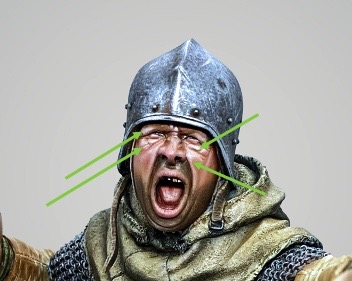Pintura de caras: diferencia entre iluminación y reflejos.
A la hora de afrontar la pintura de piel humana y en concreto retratos, personalmente intento diferenciar entre la iluminación general de dicha cara y los reflejos que la luz provoca en la piel.
Una consideración previa: la piel humana no es completamente mate sino más bien satinada en la mayoría de los casos. El propio sudor, grasa de la piel y otros factores hacen que en la mayoría de las ocasiones la luz provoque reflejos en la misma. No reflejos como si fuera metal, por supuesto, pero sí evidentes.
Esto nos lleva a contemplar el concepto de los “reflejos o brillos” en nuestro proceso de pintura, dentro del proceso general de iluminación.
Diferencia entre iluminación y reflejos.
Personalmente intento diferenciar siempre estos dos conceptos. Cuando aplico las luces en un retrato, ya sea iluminación cenital, focal o cualquier otra, el objetivo es resaltar las zonas más expuestas a la luz (normalmente frente, nariz, pómulos, barbilla…) Esto nos da la sensación de profundidad y volumen en la figura.
Una vez que completo este paso, decido en qué zonas aplicar esos brillos o reflejos (no siempre es necesario, todo dependerá del objetivo que nos hayamos marcado). Así pues, serán puntos de luz muy concretos aplicados en las zonas de máxima luz (aunque no siempre) y usando normalmente el color de la máxima luz añadiendo blanco. Se trataría pues de evidenciar las zonas de la piel donde se provocarían esos brillos con un color que tenga una gran carga de blanco.
Dependiendo de la iluminación general de la figura, estos brillos serán más grandes o más pequeños. Por ejemplo, usando una iluminación focal, los brillos serán más grandes y marcados que con una iluminación general o cenital.
Personalmente creo que esta diferenciación y aplicar brillos finales dota a las figuras un mayor realismo y fuerza en la expresión.
——————-
Rojo: zona de iluminación
Verde: brillos o reflejos

